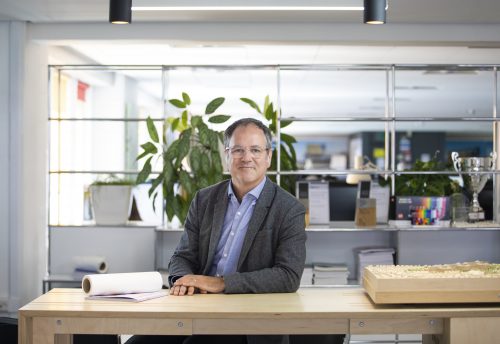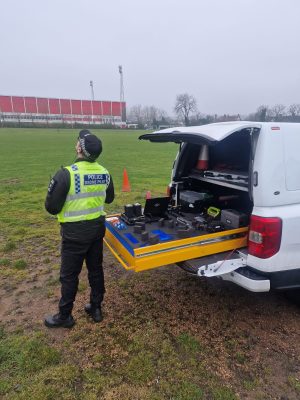Leading Bristol expert draws up blueprint for cities of the future

The head of one of the most prominent architecture practices in the South West has drawn up a blueprint for cities of the future.
Nick Fairham, is chief executive of global design practice BDP and head of the Bristol studio.
And he believes putting people at the centre of how we design and build our cities is essential.
He has drawn up a list of five key areas that need to be considered when building the cities of the future.
Urban greening gathering pace
The far-reaching benefits of greening our cities are becoming much more widely understood with planning policies evolving in response. Cities are waking up to the crucial role ‘green infrastructure’ can play in mitigating against temperature increase, water, air and soil pollution, drought, flooding and sea level rise, as well as improving quality of life. Rain gardens and sponge parks slow down or soak up the rain; street trees and green roofs improve air quality and provide important cooling effects; whilst the amplification of existing ‘green corridors’ in a city support biodiversity and have a positive impact of people’s well-being.
It was encouraging to see that Bristol ranked third among urban centres in Great Britain for greenness, according to recent research, with Exeter in pole position. A fantastic start, but there’s lots more to come. Sometimes a shift in how we think about a challenge can pay dividends too. Singapore, once branded as ‘a garden city’, then started to position itself as ‘a city in a garden’, which accelerated the thinking on the scale of greening needed.
Happier, smarter, more inclusive working
The impact of the pandemic on workplace design is still playing out and it extends far beyond the opportunity for hybrid working. Flexibility is being incorporated into all aspects of workplace design. Employers are now beginning to take seriously the importance of creating a workplace that’s truly inclusive, one that meets the needs of a team that is diverse in terms of ethnicity, gender and religion, supporting people who are neurodivergent, people with disabilities, as well as an array of personalities.
The traditional model was project-based spaces, now we are seeing task-based spaces. Think community hubs with an open invitation to the city, spots for private conversation, spaces to reflect, collaborate and socialise, much like our new Toronto studio in The Well. Sustainability is of course paramount, but not just due to looming deadlines to improve offices’ energy performance certificates (EPCs), but because employers recognise they need to reflect the shared values of their staff, fostering a sense of purpose and belonging.
Nurturing healthy communities
Design has a key role to play in how we improve the health of our populations. This year is the 75th anniversary of the NHS so there will be a renewed spotlight on how we relieve pressure on this stretched service for the benefit of generations to come. Historically, hospitals have been seen somewhat like ‘machines for healing’, but ultimately we need to be proactive not just reactive. Daylight and access to nature in large-scale healthcare facilities are vital in securing better outcomes for patients, but also for retaining and attracting staff – one of the biggest challenges we face.
We’ll also see an accelerated move towards having smaller healthcare hubs in the community, reducing the need for people to travel to hospitals. This could be a repurposed space in a shopping centre where you can see a medical professional and also be treated under one roof. Of course, the crux of the issue is how we keep people well in the first place. High quality, affordable homes, multi-generational communities that tackle isolation, mobility hubs – combining electric bike and car charging, scooter infrastructure and bus stops – that incentivise sustainable travel and green spaces have a big role to play.
Future-fit neighbourhoods
Our homes need to support us to live happy, healthy lives, and they also need to be designed to help us tackle the huge environmental challenges that lie ahead of us. A recently launched heat map identifies Bristol neighbourhoods most vulnerable to heat which could help inform future design approaches. The goal should be to passively heat and cool a home to reduce the need to rely on mechanical energy consumption, with on-site renewables to support this approach. The orientation of buildings in relation to the sun, thickness of walls and materials used, as well as sustainable drainage are all important.
Opting for the reuse of existing buildings where possible, as opposed to new build, avoids the need for carbon intensive demolition. Think semi-demountable buildings – designed for manufacture, assembly and disassembly (DfMA) – that can adapt depending on changing needs. For example, sliding partitions in a house could enable a third bedroom to be a child’s playroom or a care suite. The opportunities are endless and it’s fantastic to see advancements in technology and thinking heralding in a new era of homes.
Designing around our energy needs
The big question of course is how we power our cities in the decades to come? Designers must pay careful attention to what’s coming down the track in terms of alternative power sources. Huge efforts are underway to establish the source of our energy in the future and we’ll need to respond appropriately. Is hydrogen the next big thing? What infrastructure will be needed to support its development? Hydrogen South West, for example, is focused on creating cross-sectoral partnerships to propel the development of hydrogen infrastructure and technology in the South West of England.
The Severn Estuary location gives us a unique opportunity to be early adopters through maritime and logistics in the region. It’s a time of great challenge but also of great opportunity for innovation and change; we look forward to embracing what’s to come.









